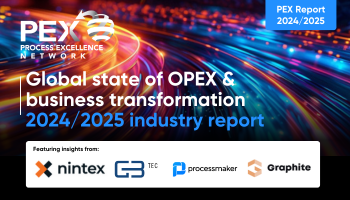How BPM helps Maersk manage diverse processes
Maersk operates on a global scale with operations in over 100 countries
Add bookmark
Business process management (BPM) is a process excellence approach that uses various methods to discover, model, analyze, measure and optimize business processes. This systematic methodology focuses on the modernization of businesses through process-driven transformation to achieve operational excellence (OPEX), efficiency and cost saving goals.
BPM helps organizations manage, improve and enhance business workflows. It is particularly helpful in accelerating digital transformation strategies, with use cases that are broad and dependent on factors such as business type, size and sector. Artificial intelligence (AI), machine learning and automation, low-code technology and process mining/intelligence are some of the key factors shaping the modern BPM landscape.
Don't miss any news, updates or insider tips from PEX Network by getting them delivered to your inbox. Sign up to our newsletter and join our community of experts.
Clear process ownership and execution
BPM plays an integral role at shipping and logistics giant Maersk, based in Copenhagen, Denmark, says Vineet Mehra, senior platform product owner at Maersk and PEX Network Advisory Board member. “Maersk operates on a global scale with operations in over 100 countries providing various logistics services. With this complexity, we also must manage business processes in more than 20 different platforms where users interact with each other.”
The company requires established clear process ownership and execution to manage its diverse processes, Mehra says. “We call these taxonomies – for example, order to cash in a business process cycle where we provide sales order generation to receive cash and resolve customer disputes. Customers and internal users interact daily with each other in these processes, and they need timely and high quality output each time.”
Maersk maps end-to-end processes so that anyone can get a view of where all different departments interact with each other, along with implementing ERPs and other platforms using application programming interface (API) and electronic data interchange (EDI) connections like booking systems connected to finance systems. “At each process step we measure productivity and performance metrics are reviewed by management to drive improvements.”
REGISTER: All Access: BPM 2024
BPM enhances transport management
BPM provides a common understanding of what is needed for delivery, including expected outcomes and interdependencies. This helps to define clear roles and responsibilities where KPIs drive performance and accountability and provide a clear measurement of success and areas to improve, Mehra says.
“We have recently deployed a new transport management system where service delivery processes interact with finance accounts payable tasks. The main objective is to pay our vendors on time as per contractual terms.” There are several dependencies in the service delivery process such as error free purchase order creation and accounting of service closure, without which the company cannot pay its vendors in a compliant manner. “BPM helps us to identify these dependencies, define measures to map processes and identify key root causes to fix defects.”
READ: BPM Adoption Framework explained by Caspar Jans
Align people with function outcomes
Alignment of people around function outcomes and their roles in achieving them is key to BPM success, says Mehra. BPM leaders should then design processes that aim to reach these outcomes in the most efficient and effective manner, he adds. Add technology that is scalable, reliable and predictable using data and insights to drive better processes.
Maersk operates a three-phase approach, Mehra says. “It starts with the business product team who define the end goal of business and customer needs. Then come functional product owners who fulfill the design of business processes. They document the process, policy and establish clear roles and responsibilities for users. Finally, platform product owners partner with technology to articulate business requirements into user stories, manage product lifecycles, development, deployment and adoption.”
PEX Report 2024 global state of process excellence

PEX Network's annual report reveals the current state and future trends of process excellence. Based on a study profiling hundreds of global process excellence leaders, the report provides insights on how to leverage innovation, generative AI, and process intelligence to achieve operational excellence, customer-centricity, and organizational growth. Download your copy of the PEX Report 2024/2025 today and benchmark your process excellence journey against your peers.
Download Now































